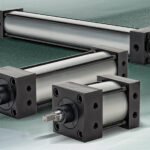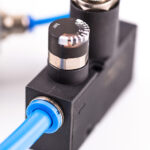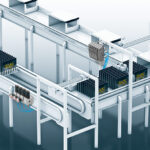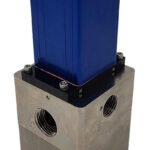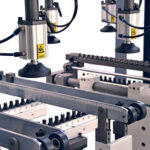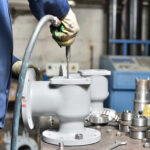By Josh Cosford, Contributing Editor Pneumatic actuators take advantage of compressed air to provide your machine with quick and powerful actuation of nearly infinite possible functions. Pneumatic actuators may take the form of cylinders, motors, slides, grippers and rotary actuators, each of which receives pressurized and compressed air to create linear or rotational force. The […]
Engineering Basics
How do pneumatics technologies work?
Pneumatics is a fluid power technology similar to hydraulics in that it transmits force through a pressurized medium to create useful work. However, pneumatic technology differs from hydraulics in every critical fashion — compressibility. To be fair, hydraulic oil compresses as well, but only 0.4 percent every thousand psi or so. However, in the simplest […]
What are pneumatic rotary actuators?
By Josh Cosford, Contributing Editor Rotary actuators are devices used to transmit torque through a limited rotational arc. Rather than pneumatic motors, which rotate continuously, pneumatic rotary actuators move a load through a limited range of motion. Some actuators rotate through two discrete positions, while others are capable of positioning at any angle around the […]
How do you specify electropneumatic flow controllers and regulators?
Electropneumatic flow controllers and regulators are by nature both electrical and mechanical, thus requiring the designer to develop two sets of specifications for the regulator to function properly. The pneumatic or mechanical portion of the device is the same as a standard flow control valve or regulator. As with many things in fluid power, the […]
Designing optimum pneumatic systems for food & beverage packaging
These tips not only adhere to food safety guidelines, but also serve to improve machine utilization and performance. By Steve Bain, Food and Beverage Industry Segment Manager, Festo Before describing the four pneumatic automation design tips for food and beverage packaging applications, it is a good idea to answer a fundamental question: Why apply pneumatic […]
Can electropneumatic regulators be used in hazardous locations?
When thinking of hazardous locations, one’s mind conjures an oil/gas drilling rig, refinery, or underground coal mine — all these locations have in the past utilized traditional pneumatics as risk reduction because they do not have a spark risk, which a solenoid’s electrical actuation requires and creates. Expanding our view of hazardous locations, we should […]
Pneumatic systems: an introductory primer and actuator selection guide
Norgren pneumatics expert Dietmar Grün provides a thorough introduction to pneumatic systems, addressing application areas, core components, the critical role of pneumatic air preparation and treatment products and pneumatic actuators and key considerations for selecting pneumatic actuators. Contributed by Dietmar Grün, Product Manager, Motion Control, Actuator, Norgren Pneumatic systems harness the energy generated by the […]
Using compressed air hoses safely
Compressed air is often disregarded as a common utility in factories, but risks are high with pressurized air running through pneumatic hoses. Learn how to use these tools safely. Contributed by Mindy Schoeff, Marketing Communications Manager and Ron Hibbler, Applications Manager, Proportion-Air Compressed air is nearly ubiquitous in factories. It’s part of the power behind everything […]
Are electropneumatic controllers suitable for vacuum applications?
Both electropneumatic pressure regulators and flow control valves can be utilized in controlling vacuum systems. By using an electropneumatic pressure regulator, the designer develops a system which the suction force of the vacuum cup can be precisely controlled. The function of the electropneumatic flow control remains the same when controlling the flow of air in […]
Can electropneumatic controllers control force, tension, and torque?
Contributed by Justin Fluegel An electro-pneumatic pressure regulator is an ideal option to control the force, tension, or torque within a system. The pressure within a system directly correlates to the amount of force available to the actuator — lower pressure results in a lower force and vice versa. For the controller to regulate the […]

